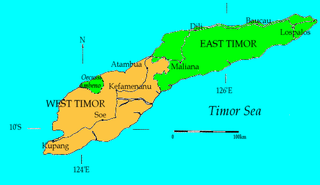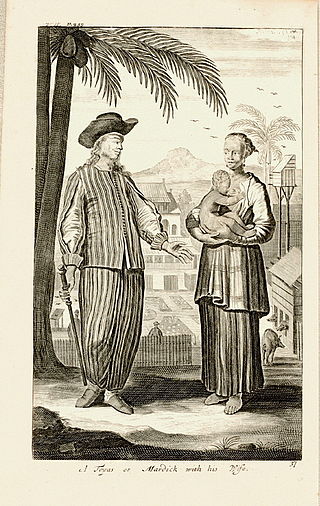Related Research Articles

West Timor is an area covering the western part of the island of Timor, except for the district of Oecussi-Ambeno. Administratively, West Timor is part of East Nusa Tenggara Province, Indonesia. The capital as well as its main port is Kupang. During the colonial period, the area was named Dutch Timor and was a centre of Dutch loyalists during the Indonesian National Revolution (1945–1949). From 1949 to 1975 it was named Indonesian Timor.

Adonara is an island in the Lesser Sunda Islands of Indonesia, located east of the larger island of Flores in the Solor Archipelago. To the east lies Lembata, formerly known as Lomblen. Adonara is the highest of the islands of the archipelago, reaching an altitude of 1,659 metres, and it has an area of 529.75 km2. It is situated administratively in the East Flores Regency of East Nusa Tenggara province.

Kupang, formerly known as Koepang or Coupang, is the capital of the Indonesian province of East Nusa Tenggara. At the 2020 Census, it had a population of 442,758; the official estimate as of mid-2023 was 466,632. It is the largest city and port on the island of Timor, and is a part of the Timor Leste–Indonesia–Australia Growth Triangle free trade zone. Geographically, Kupang is the southernmost city in Indonesia.

Amabi was a traditional principality in West Timor in the currently East Nusa Tenggara province of Indonesia. From at least the 17th century to 1917, Amabi played a role in the rivalries between the Portuguese and Dutch colonials on Timor Island.

Topasses were a group of people led by the two powerful families – Da Costa and Hornay – that resided in Oecussi and Flores. The Da Costa families were descendants of Portuguese Jewish merchants and Hornay were Dutch.
Gaspar da Costa was the leader or tenente geral of the Portuguese-speaking Topasses, a Eurasian group that dominated much of the politics on Timor in the early modern period. He was largely responsible for the dramatic collapse of Portuguese power in West Timor, a process that laid the foundations for the modern division of Timor in an Indonesian and an independent part.

Wehali is the name of a traditional kingdom at the southern coast of Central Timor, now in Indonesia and East Timor. It is often mentioned together with its neighbouring sister kingdom, as Wewiku-Wehali (Waiwiku-Wehale). Wehali held a position of ritual seniority among the many small Timorese kingdoms.
Liurai is a ruler's title on Timor. The word is Tetun and literally means "surpassing the earth". It was originally associated with Wehali, a ritually central kingdom situated at the south coast of central Timor. The sacral lord of Wehali, the Maromak Oan enjoyed a ritually passive role, and he kept the liurai as the executive ruler of the land. In the same way, the rulers of two other important princedoms, Sonbai in West Timor and Likusaen (Liquica) in East Timor, were often referred as liurais, which indicated a symbolic tripartition of the island. In later history, especially in the nineteenth and twentieth centuries, the term liurai underwent a process of inflation. By this time it denoted any ruler in the Portuguese part of Timor, great or small. In the Dutch part in West Timor the title appears to have been restricted to the Sonbai and Wehali rulers. The rulers in the west were known by the Malay term raja, while there were internally used terms such as usif (lord) among the Dawan-speaking groups, and loro (sun) among the Tetun speakers.

Amanuban was a traditional princedom in West Timor, Indonesia. It lay in the regency (kabupaten) Timor Tengah Selatan. In the late colonial period, according to an estimate in 1930, Amanuban covered 2,075 square kilometers. The centre of the princedom since the 19th century was Niki-Niki. The population belongs to the Atoni group. Today they are predominantly Protestants, with a significant Catholic minority and some Muslims.

Amanatun was an Atoni princedom situated in what is today Indonesian West Timor, which existed up to 1962. It was also known as the princedom of Onam. The area once included one of the best ports where the commercially important sandalwood was loaded on Dutch and Portuguese ships.
Sonbai Besar or Greater Sonbai was an extensive princedom of West Timor, in present-day Indonesia, which existed from 1658 to 1906 and played an important role in the history of Timor.
Sonbai Kecil or Lesser Sonbai was an Atoni princedom in West Timor, now included in Indonesia. It existed from 1658 to 1917, when it merged into a colonial creation, the zelfbesturend landschap Kupang.
Gelgel is a village (desa) in the regency (kabupaten) of Klungkung, on Bali, Indonesia. The village, near the coast four kilometers south of the regency capital Semarapura, contains some structures of cultural interest and is known for its pottery and handwoven ceremonial songket cloth.

Dalem Di Made was a king of Bali who may have reigned in the period 1623–1642. He belonged to a dynasty that claimed descent from the Majapahit Empire of Java, and kept residence in Gelgel, close to Bali's south coast.
Anglurah Agung, also known as Gusti Agung Di Made or Gusti Agung Maruti, was a king of Gelgel, the paramount kingdom on Bali, who ruled at a time when the political unity of the island began to break down. This process led to the permanent division of Bali into several minor kingdoms by the late 17th century.
Amarasi was a traditional princedom in West Timor, in present-day Indonesia. It had an important role in the political history of Timor during the 17th and 18th century, being a client state of the Portuguese colonialists, and later subjected to the Netherlands East Indies.
The Blambangan Kingdom was the last Javanese Hindu kingdom that flourished between the 13th and 18th centuries, based in the eastern corner of Java. The capital was at Banyuwangi. It had a long history of its own, developing contemporaneously with the largest Hindu kingdom in Java, Majapahit (1293–1527). At the time of the collapse of Majapahit in the late fifteenth century, Blambangan stood on its own as the one solitary Hindu state left in Java, controlling the larger part of Java’s Oosthoek.
The Battle of Penfui took place on 9 November 1749 in the hillside of Penfui, near modern Kupang. A large Topass army was defeated by a numerically inferior Dutch East India Company force following the withdrawal of the former's Timorese allies from the battlefield, resulting in the death of the Topass leader Gaspar da Costa. Following the battle, both Topass and Portuguese influence on Timor declined, eventually leading to the formation of a boundary between Dutch and Portuguese Timor which precipitated into the modern border between West Timor and East Timor.
References
- ↑ H. G. Schulte Nordholt (1971), The political system of the Atoni of Timor, pp. 262-74.
- ↑ A. de Roever (2002), De jacht op sandelhout, pp. 248-69.
- ↑ H.G. Schulte Nordholt (1971), The Political System of the Atoni of Timor, pp. 155.
- ↑ Hägerdal, Hans (2012-01-01). Lords of the Land, Lords of the Sea: Conflict and Adaptation in Early Colonial Timor, 1600-1800. BRILL. p. 68. ISBN 978-90-04-25350-6.
- ↑ "Sonbai Article". Archived from the original on 2011-07-15. Retrieved 2008-12-30.
- ↑ Hägerdal, Hans, ed. (2009). Responding to the West: Essays on Colonial Domination and Asian Agency. Amsterdam University Press. p. 52. ISBN 978-90-8964-093-2.